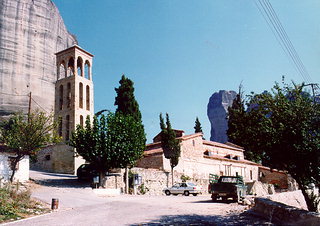
The church of the Assumption of Virgin Mary, which is found in the old city, was erected between the 10th and the 11th century on the ruins of an old Christian “basilica” church. The order (way of building) is “trikliti” (triforium) basilica of mixed type “it has very high and lit the intermediate “klitos” (aisle) of the narthex and the “trivilo”.
The outer narthex was added in the 16th century. In the southern wall there are surrounded with wall externally a lot of ancient parts of bas-reliefs (rodakes representations wrought in relief, signs, capes etc.), as well as old Christian sculpture with a vine-shoot.
– From the sculpture decoration of the Byzantine basilica, the oldest is the marble “kivorio” (tomb) of the Holy Altar found in the Sanctuary.
– Special interest presents the unique in Greece marble pulpit that imposingly is raised at the centre of the intermediate “klitos” in front of the Holy Gate. It has been reconstructed to its biggest part from architectural parts of the old pulpit.
– The murals of the church are dated from the 12th until the 16th century and are of exceptional interest.
A lot of murals were created in 1573 by priest Kiriazis and by Neofytos, son of the eminent painter Theofanis from Crete.
The most important of the temple’s portable pictures is the both sides’ painted picture, which on the one side portrays the Assumption of Virgin Mary and on the order the Christ’s Crucifixion.
The two now separate, pictures after the theft and their restoration are kept in the Varlaam Monastery of the Meteora.
The wood carved temple of the church belongs to the appreciable work of the post Byzantine wood carving and it was created during the 17th century.
In a little depth on the front left part of the main temple, part of a mosaic flooring had been revealed.
As we enter the temple on the northern wall of the inner narthex they are written, with capital letters writing, the “golden bull” of the Emperor Andronikos c’ Paleologos 1336 with which the borders of the Bishopric of Stagi are determined and privileges are granted, as well as the “sigilio” (the Patriarch’s edict) of the Ecumenical “universal”. Patriarch Antonios D’ 1393 with which the privileges of the Bishopric of Stagi – that various emperors of Byzantium had granted occasionally – are renewed.
Impressive and imposing is also the church’s bell tower, found on the northern side of the entrance in the grounds of the church.

